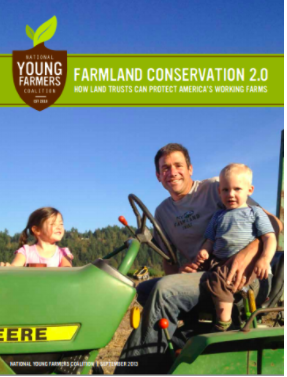A 2013 survey of 200 land trusts in the U.S. The report reveals how farmland conservation practices have been failing working farmers and outlines how land trusts can protect working farms.
This National Young Farmers Coalition report reveals how current farmland conservation practices are failing working farmers. Farmland Conservation 2.0: How Land Trusts Can Protect America’s Working Farms surveyed 200 land trust leaders from across the United States and found that one-quarter of land trusts have seen protected farmland move out of production. Land is going fallow as non-farmers purchase farms at prices beyond what farmers can afford. As a result, farmers are being pushed hundreds of miles from urban markets as they look for land to buy.
“Land access is one of the top challenges for young farmers,” says Lindsey Lusher Shute, Director of the Coalition, “there are innovative farmland conservation models that can help, but they must be scaled up with new leadership from the land trust community. Today, we ask land trusts to partner with the next generation of farmers and set a new bar for farmland conservation – one that includes the farmer as an essential component of a successful farm. Without the farmer, the farm cannot survive.”
Report findings include:
- 24 percent of land trust respondents said that they had seen farmland protected with conservation easements taken out of production.
- Non-farmers are the #1 threat to the continued use of protected farmland. Traditional conservation easements are designed to protect farmland from residential and commercial development, but they do not prevent non-farmers from purchasing protected farms as estate properties. Land transitioning away from farmer ownership contributes to the trend of farms being underutilized or taken out of production altogether.
- Very few land trusts are making use of new conservation practices that ensure farms are owned and managed by qualified farmers and therefore stay in production. More than two-thirds of land trusts reported that they are not using these tools.
- Young farmers represent valuable partners for land trusts seeking to protect working farms, but only 18 percent of land trusts reported that they are helping to transition working farmland to the next generation of farmers.
- Bringing farmland affordability strategies to scale will require incentives from public and private sector funders of the land conservation community, professional development training, and strategies to minimize perceived risks for land trust boards.

